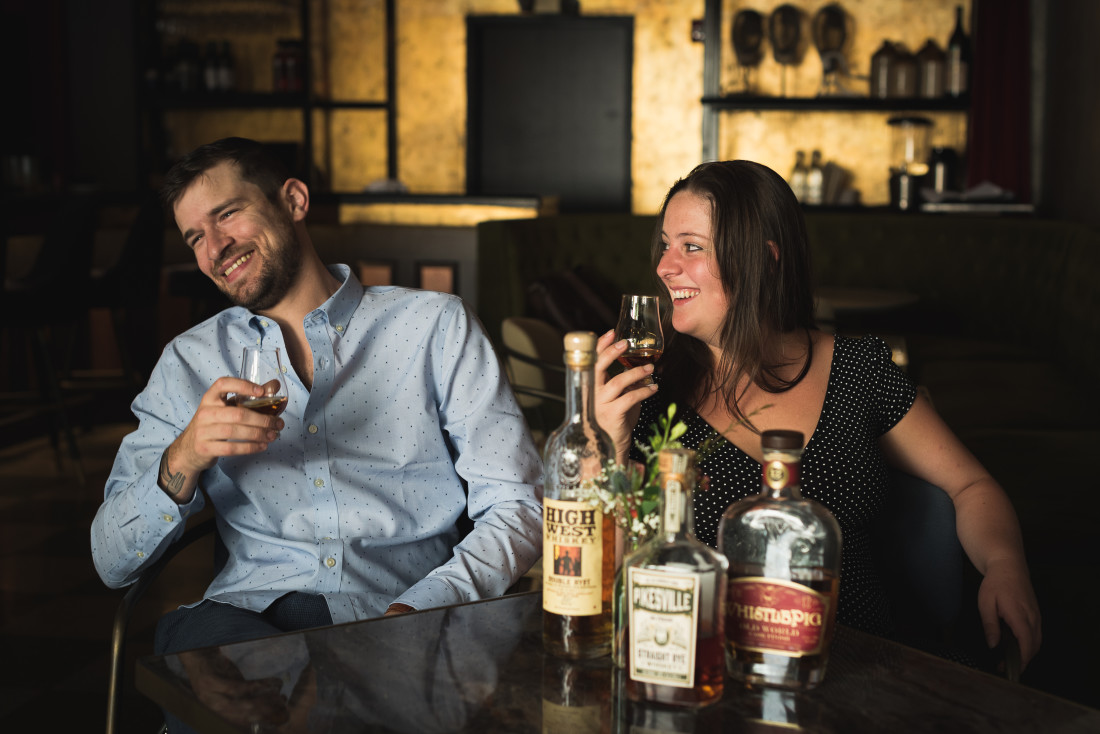It’s a quirk of popular culture that things go in and out of fashion. Women’s skirt hemlines get longer and shorter; men’s neckties get wider and skinnier. And often the changes seem capricious, not based on practical concerns. But when it comes to spirits, the popularity of a particular alcoholic beverage can ebb and flow for reasons that make sense.
To a large extent, that’s been the case with rye whiskey. Though it was out of favor — and hard to find on liquor store shelves — for a generation, the grain-based spirit has a long history in the United States. In fact, rye whiskey was one of the earliest alcoholic beverages distilled in the New World. “Its history goes all the way back to the 1600s,” says Chris Faber, vice president of the Asheville chapter of the U.S. Bartenders’ Guild and co-owner of the soon-to-open downtown bar, Save Me the Waltz.
“The German culture — the ‘Pennsylvania Dutch’ — started making rye here,” he explains. The grain grows well in Europe’s “rye belt,” a region that includes Poland, northern Germany and some of the former western Soviet satellite countries. Domestically, “rye became immensely popular and was produced mostly in the Northeast,” Faber says. In fact, two of the names most associated with domestic rye whiskey, Beam and Overholt, are families of Germanic descent.
Rye became a spirit of choice after the American Revolution, when another popular alcoholic beverage suddenly became unavailable. “We couldn’t get rum anymore, because the British, Spain and France controlled the Caribbean,” where rum was produced, Faber explains. Rye’s popularity blossomed, and a number of classic cocktails — the Old Fashioned, the Manhattan, the Boulevardier — would develop around the spirit.
But distilling from rye was always expensive because, unlike corn, the grain contains comparatively little sugar. And sugar is needed for fermentation, a critical step in spirit-making. Faber says that in the earliest days, farmers would make rye whiskey from surplus unsold grain; mass production would have been prohibitively expensive.
In the 1800s, the Sazerac cocktail, originally made with cognac, became popular in New Orleans and beyond. Bartenders switched to rye as the primary ingredient when a grape blight in France made cognac extremely rare and expensive. Beginning in 1920, the 18th Amendment made all alcoholic beverages in the U.S. illegal until Prohibition was repealed in 1933.
Even with the return of legal booze, many distillers switched to industrial alcohol production during World War II. Rye continued to be moderately popular until the late 1960s, when tastes changed (or were guided) toward sweeter cocktails. Only with the birth of 21st-century craft cocktail culture has rye once again become widely available on liquor store shelves and behind the bar.
Today, the distinctive whiskey is a popular ingredient in classic and modern cocktails, and it increasingly shows up in the cabinets of home bartenders. “I see a resurgence of people wanting to know how to do things with their hands,” says Emily Nyokka of Post 70 Indulgence Bar. “It’s a curiosity and fascination with how things used to be.”
Rye is easily distinguished from other whiskeys by its flavor profile. “The whiskey follows the grain,” Faber says. “So rye whiskey tends to be spicy and astringent, without the sweetness you’d get in bourbon.” Nyokka says that rye’s flavor can remind some of rye bread. (But not the caraway flavor of seeded rye bread; that’s a flavor you find in kummel or akavit, spirits we’ll cover in future columns.)
Both Faber and Nyokka mention Old Overholt as a well-known, inexpensive and easily found rye whiskey. But Post 70’s selection includes at least a half dozen rye-based spirits, each with its own character. Woodford Reserve is a popular choice. Dickel is spicier and more assertive — we found it to have more character overall. Knob Creek is a 100-proof rye with a milder spice profile and a faint hint of peanut. Rittenhouse tends toward the peppery side.
To be classified as rye whiskey, a spirit need contain only 51 percent rye-based alcohol, so distillers often add complexity (or smoothness or character) by adding distillates from other grains. Nyokka has good things to say about most rye whiskeys but suggests that first-timers not start with a high-proof variety like Knob Creek. Faber notes that rye, like other spirits, mellows with age. “When you get a little more barrel age on rye, it softens a bit,” he says.
Faber encourages those who enjoy a good cocktail to try it the classic way, and that often means using rye. We can vouch for his Vieux Carré recipe (see sidebar). While many recipes call for all sweet ingredients, the spicy rye in Faber’s version balances nicely with the other components of the drink. “In a Manhattan or a Sazerac, the difference between rye and bourbon is amazing,” he says. “And if you’re drinking those cocktails with bourbon — like most people do —you’re not having it the way it was originally intended.”
Save Me the Waltz, a craft cocktail bar and jazz club named after Zelda Fitzgerald’s 1932 semiautobiographical novel, is scheduled to open in late September downtown at 56 Patton Ave. in the space previously occupied by Ellington Underground. Post 70 Indulgence Bar is at 1155 Tunnel Road.




Before you comment
The comments section is here to provide a platform for civil dialogue on the issues we face together as a local community. Xpress is committed to offering this platform for all voices, but when the tone of the discussion gets nasty or strays off topic, we believe many people choose not to participate. Xpress editors are determined to moderate comments to ensure a constructive interchange is maintained. All comments judged not to be in keeping with the spirit of civil discourse will be removed and repeat violators will be banned. See here for our terms of service. Thank you for being part of this effort to promote respectful discussion.